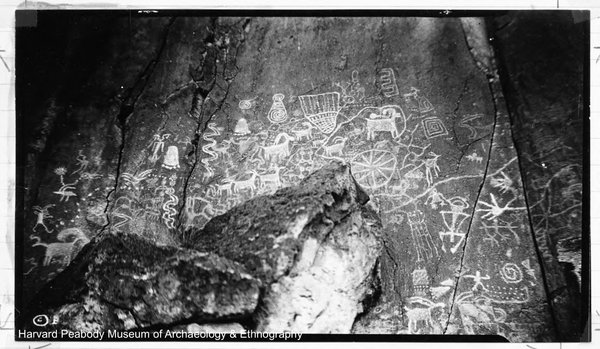Dublin Core
Title
Description
Water is more than a force of nature that shapes our landscapes. How humans rely on this essential resource shapes culture. In Clear Creek Canyon, Fremont and Paiute history show what water means to Indigenous peoples, both ancient and modern. The Paiute name for Clear Creek is "Red Reed Water," and it has long been a source of life, inspiration, community, and identity.
Around 800 years ago, Fremont people first settled on Five Finger Ridge, where they grew crops, gathered wild seeds, and hunted along Clear Creek. It was the largest Native village in the canyon, and its pit houses sat high above the creek to give residents a good view of travelers below. After the Fremont abandoned Five Finger Ridge around 1350, other Native peoples left their mark in the canyon. Hunting parties gathered at streams, knowing that the deer would come. Women collected chokecherries, elderberries, watercress, and willows along the water’s edge. People moved seasonally and are connected to the wider Native story of Clear Creek because the water shaped their livelihood and travels.
Today, the Koosharem Band of the Southern Paiute Tribe live to the southeast of the Canyon and the Kanosh Band to the west. For both, water influenced their rock art, their pottery, and their belief systems. In fact, water is so central to Paiute identity, it is laced through their own names. In their language, the word “Pa” means water and “Pa-Ute” means “water people.” The Koosharem Band of Paiute were once known as the “Water Clover People.” The Kanosh Band were known as the Pahvants, meaning, “water is there.” Paiutes also used their term for water jugs to refer to themselves, since their people were known for water carriers made from split willows coated inside and out with pine pitch.
Where water was, the people gathered. Water is so a part of their lifeway that when Paiutes now serve as tribal consultants on building projects, the first question they ask is, “where is the water?” They know that where there is water, their ancestors once were.
Creator
Source
_______________
See Fremont Indian State Park Museum, exhibition file for “Carved Rock” curated by Amy Ramsland Larsen, 2020.

